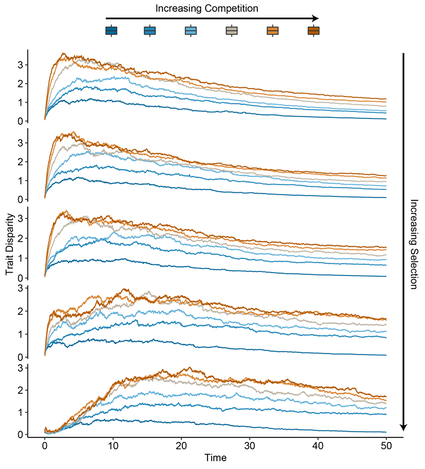
Opposing effects of competition and selection on macroevolutionary dynamics
Species interactions are thought to be among the primary drivers of diversification patterns. In particular, competition between species can both drive speciation, by pushing species to occupy distinct areas of niche space and diverge among the trait axis under competition, or limit speciation if the niche space is saturated and competition prevents new species from evolving. Conversely, stabilising selection can lead to narrower trait space as species converge on adaptive peaks and are unable to move from them.
Examining how competition and selection interact to generate different patterns of diversity is the main topic of my post-doctoral research with Gavin Thomas, funded by a Royal Society grant.
Stay tuned for updates on this project as it evolves!
Species interactions are thought to be among the primary drivers of diversification patterns. In particular, competition between species can both drive speciation, by pushing species to occupy distinct areas of niche space and diverge among the trait axis under competition, or limit speciation if the niche space is saturated and competition prevents new species from evolving. Conversely, stabilising selection can lead to narrower trait space as species converge on adaptive peaks and are unable to move from them.
Examining how competition and selection interact to generate different patterns of diversity is the main topic of my post-doctoral research with Gavin Thomas, funded by a Royal Society grant.
Stay tuned for updates on this project as it evolves!
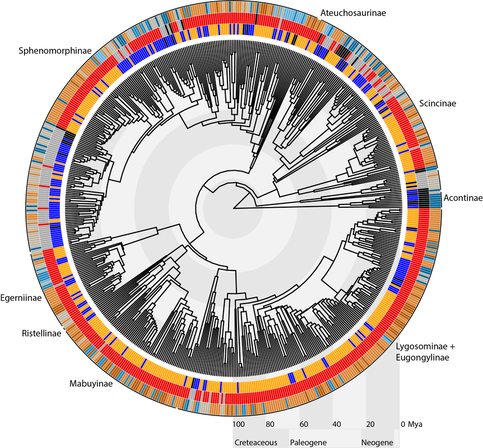
Global skink diversity
There are over 1700 species of skinks currently described, making Scincidae among the richest families of land vertebrates. They are also extremely diverse in morphology, behaviour, habitat use, reproductive strategies, and feeding ecology. They are found almost worldwide, and an extraordinary hotspot of skink diversity exists in Australia, where hundreds of different species occur on the continent.
Working with the labs of Shai Meiri and David Chapple, we examine macroevolutionary trends in the diverse radiation of skinks. We aim to understand how different traits are distributed on the phylogeny of skinks, and what processes drove their evolution.
Results from this project have been published in Evolution. In this work, we explored the evolution of diel activity times in skinks. We found that skinks were probably ancestrally non-diurnal, with strict diurnal habits only evolving later during skink phylogeny, possibly in association with terrestrial habits and colder temperatures, whereas non-diurnal species are associated with warm temperatures, fossorial life styles, and limb reduction and loss.
There are over 1700 species of skinks currently described, making Scincidae among the richest families of land vertebrates. They are also extremely diverse in morphology, behaviour, habitat use, reproductive strategies, and feeding ecology. They are found almost worldwide, and an extraordinary hotspot of skink diversity exists in Australia, where hundreds of different species occur on the continent.
Working with the labs of Shai Meiri and David Chapple, we examine macroevolutionary trends in the diverse radiation of skinks. We aim to understand how different traits are distributed on the phylogeny of skinks, and what processes drove their evolution.
Results from this project have been published in Evolution. In this work, we explored the evolution of diel activity times in skinks. We found that skinks were probably ancestrally non-diurnal, with strict diurnal habits only evolving later during skink phylogeny, possibly in association with terrestrial habits and colder temperatures, whereas non-diurnal species are associated with warm temperatures, fossorial life styles, and limb reduction and loss.
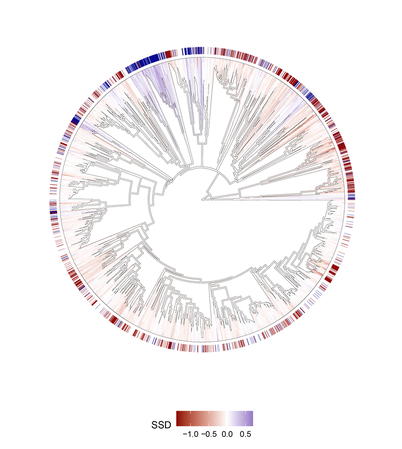
Evolution of sexual size dimorphism
The degree of sexual size dimorphism (SSD) varys widely across the tree of life. Some taxa are predominantly male-biased, others predominantly female-biased, and many are monomorphic. Reasons for why these patterns of SSD differ vary from sexual selection (e.g. larger males are favoured in male combat) to ecological divergence (e.g. males and females specialise in different niches to reduce competition).
In my post-doctoral research with Gavin Thomas, I explore whether and how varying rates of size evolution can explain differences in degrees of SSD.
Details on this project to come as it matures and grows in size!
The degree of sexual size dimorphism (SSD) varys widely across the tree of life. Some taxa are predominantly male-biased, others predominantly female-biased, and many are monomorphic. Reasons for why these patterns of SSD differ vary from sexual selection (e.g. larger males are favoured in male combat) to ecological divergence (e.g. males and females specialise in different niches to reduce competition).
In my post-doctoral research with Gavin Thomas, I explore whether and how varying rates of size evolution can explain differences in degrees of SSD.
Details on this project to come as it matures and grows in size!
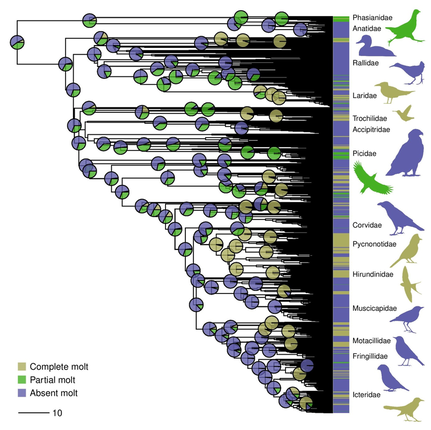
Evolution of moult strategy in birds
Birds are a phenominanly succesful group of vertebrates, in large part thanks to their ability to fly using their flight feathers. Quality of flight feathers is thus crucial, yet birds high quality feathers take long to grow, and fledgling birds must leave the nest as soon as possible to minimise risk of predation.
Led by Yosef Kiat from the Animal Flight Group in Haifa University, we explored the evolutionary history of moult strategy in the first year of birds' lives. We found support for an ancestral bird that did not moult its flight feathers in its first year, with complete moult during the first year of life evolving only later in bird evolutionary history, coinciding with a decrease in body size and associated with distribution in lower latitudes.
This work has been published in Scientific Reports.
Birds are a phenominanly succesful group of vertebrates, in large part thanks to their ability to fly using their flight feathers. Quality of flight feathers is thus crucial, yet birds high quality feathers take long to grow, and fledgling birds must leave the nest as soon as possible to minimise risk of predation.
Led by Yosef Kiat from the Animal Flight Group in Haifa University, we explored the evolutionary history of moult strategy in the first year of birds' lives. We found support for an ancestral bird that did not moult its flight feathers in its first year, with complete moult during the first year of life evolving only later in bird evolutionary history, coinciding with a decrease in body size and associated with distribution in lower latitudes.
This work has been published in Scientific Reports.
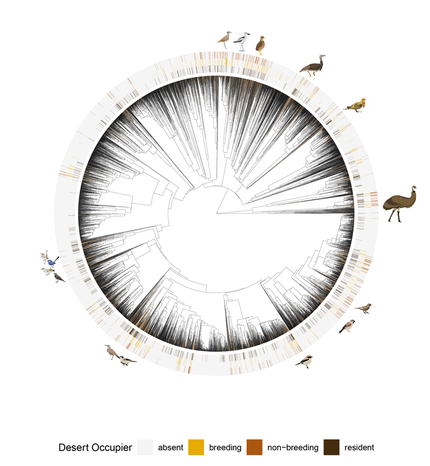
Phylogenetic and morphological patterns in desert-dwelling birds
The world's arid regions are extremely extensive, and often home to unique, highly specialised fauna - yet many view them as barren wastelands mostly devoid of life. In birds, the deserts of the world are where diversity is lowest, in stark contrast to the tropics. However, are desert birds merely the few who manage to persist in deserts, or do they have their own unique evolutionary story?
In my post-doctoral research with Gavin Thomas, I explore if desert-dwelling birds display phylogenetic clustering, which areas of the bird morphospace they occupy, and test well-established hypotheses on associations between their traits and desert habitats.
Details on this project as it spreads wings!
The world's arid regions are extremely extensive, and often home to unique, highly specialised fauna - yet many view them as barren wastelands mostly devoid of life. In birds, the deserts of the world are where diversity is lowest, in stark contrast to the tropics. However, are desert birds merely the few who manage to persist in deserts, or do they have their own unique evolutionary story?
In my post-doctoral research with Gavin Thomas, I explore if desert-dwelling birds display phylogenetic clustering, which areas of the bird morphospace they occupy, and test well-established hypotheses on associations between their traits and desert habitats.
Details on this project as it spreads wings!
